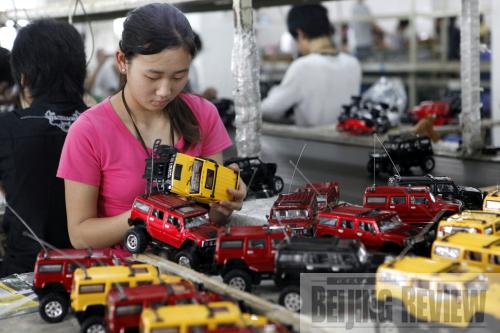|
 |
|
NOT SO JOLLY: The waning consumer sentiment in Western countries has put a freeze on Christmas orders from many Chinese exporters (MA KA) |
Wandering through his toy factory in Shenzhen, Guangdong Province, Lin Zhanpeng barks orders as a few workers move around machines and clean up the dusty workshop—not for production but for a half-year rent-out.
During the past three months, supposedly the busiest season of the year, the workshop has remained idle with assembly lines accumulating dust. Only two years ago, this would have been unimaginable, as outpouring export orders kept all of Lin's machines humming for extra hours to fill store shelves in the run-up to Christmas.
"This year the festive orders are coming in, but at least 30 to 40 percent fewer than last year," said Lin, founder and owner of Shenzhen Huida Toy Factory. "It's getting even worse these days and our profit margin has continued to narrow."
The factory, he added, has halved employment to barely 70 workers and has resorted to leasing out one third of its workshops to plug holes in the battered balance sheet.
Despite a grim prospect ahead, Lin said he will do whatever it takes to hold up the family business that has been in production since as early as 1997.
Lin's experience is not a singular occurrence but a vivid picture of what is happening in south China's Pearl River Delta, the established hotbed of the mainland manufacturing industry that makes a staggering array of products, from garments and watches to toys and plastics.
In past years, the export-dependent growth model has encountered numerous obstacles that threatened to damage the "world's workshop," including the 1997 Asian financial crisis, appreciation of the renminbi, safety concerns and intractable trade disputes. But never before has the crisis escalated to such an extent that it causes massive factory closures and painful layoffs.
The vibrant demand for cheaply-priced Chinese goods has shriveled as the economic crisis discourages U.S. consumers from spending. A looming recession in Europe and Japan also makes switching exports to other high-income markets a remote option. The export woes quickly filtered through investments and employment, which spiraled downward to dampen the situation on the trade front.
By handing out generous tax rebates and subsidy assistance, the government tried to staunch the pain, but with foreign buyers tightening their belts, exporters were left wringing their hands and despairing over the shrinking possibilities for a quick upturn in their fortunes.
Exports nationwide from January to June nosedived 21.8 percent year on year to $521.5 billion, according to the General Administration of Customs.
Christmas will surely be very tough for exporters this year as demand from overseas markets remains lackluster, said Guo Tianyong, a senior economist with the Central University of Finance and Economics. Since pessimism still hangs over the U.S. economy, it may still take a while for American consumers to begin reaching for their wallets once again, he added.
Zuo Xiaolei, Chief Economist with China Galaxy Securities Co. Ltd., agreed. "Whether the export machine can be restarted in the coming months will depend to a large extent on how well the Western economies fare," she said.
On the defense
With the dismal sales outlook on everyone's mind, exporters are trying innovative strategies to draw customers in during the most competitive time of the year. Taking to the Internet, some exporters have started offering online promotions with which to approach foreign buyers while others seek to explore emerging markets in Africa and South America that were not previously considered profitable markets.
| 